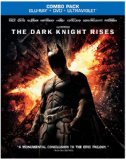| Reviews & Columns |
|
Reviews DVD TV on DVD Blu-ray 4K UHD International DVDs In Theaters Reviews by Studio Video Games Features Collector Series DVDs Easter Egg Database Interviews DVD Talk Radio Feature Articles Columns Anime Talk DVD Savant Horror DVDs The M.O.D. Squad Art House HD Talk Silent DVD
|
DVD Talk Forum |
|
|
| Resources |
|
DVD Price Search Customer Service #'s RCE Info Links |
|
Columns
|
|
|
Dark Knight Rises, The
Warner Bros. // PG-13 // December 4, 2012
List Price: $35.99 [Buy now and save at Amazon]
The Film:
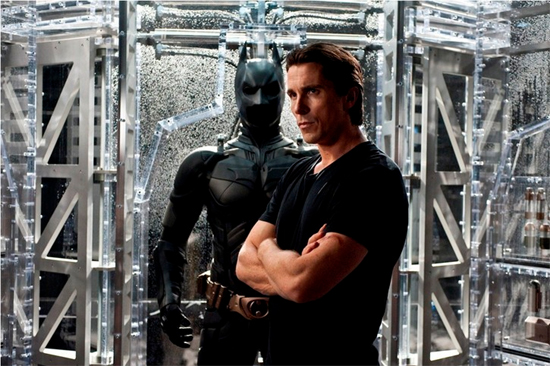
In The Dark Knight Rises, Christopher Nolan's grand conclusion to his Batman trilogy, an unassuming scene captures the essence of what resonates with me in this outlook on the hero: a beat cop turned detective, John Blake (Joseph Gordon-Levitt), walks the streets of a ravaged, desolate Gotham, using a piece of chalk to draw modified Bat-symbols. It's an emblem of hope and fortitude, during a time when there's no assurance that the city's demonized guardian would pull them from the vice of anarchy threatening to wipe Gotham off the face of the map. Orchestrated with bombast to spare, the situation leaves one wondering whether they'll even be able to survive this hopelessness, marked by lethal twists-'n-turns and a decimated social infrastructure. To say that the execution of Rises' revolutionary setting comes as a surprise -- both in rewarding conventionalism and how it pushes realism to the edge of plausibility for its complex theatrics -- would be an understatement, and the way the hero emerges to answer the call of those chalked symbols does nothing short of exhilarate.
From the beginning, Nolan and his writers -- David S. Goyer for Begins, Jonathan Nolan for The Dark Knight and Rises -- have incorporated elements of the graphic novels into their trilogy, only tweaked to fit into the universe's tone and realism. Taking pages from "The Dark Knight Returns" at first, where they set up a point for an older, retired, grieving Batman to reemerge, the story advances forward eight years to a time when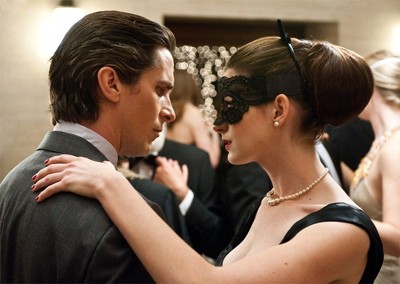 organized crime has been largely contained through an initiative called the Dent Act. Following the events of The Dark Knight, where Batman is forced to hide in the shadows due to suspicion of murder, Bruce Wayne (Christian Bale) lets himself wither in the halls of his echoic lofts of his mansion, lamenting the losses of loved ones and brooding over his moral choice for the greater good of Gotham. This peace doesn't last, though: a new threat, the muscular and masked idealist named Bane (Tom Hardy), gradually plants seeds of destruction around the city that drives Batman out of the shadows, once he delivers a personal blow to Bruce. He's there to make sure that Gotham is reduced to ashes, but not without suffering.
organized crime has been largely contained through an initiative called the Dent Act. Following the events of The Dark Knight, where Batman is forced to hide in the shadows due to suspicion of murder, Bruce Wayne (Christian Bale) lets himself wither in the halls of his echoic lofts of his mansion, lamenting the losses of loved ones and brooding over his moral choice for the greater good of Gotham. This peace doesn't last, though: a new threat, the muscular and masked idealist named Bane (Tom Hardy), gradually plants seeds of destruction around the city that drives Batman out of the shadows, once he delivers a personal blow to Bruce. He's there to make sure that Gotham is reduced to ashes, but not without suffering.
The Dark Knight generated substantial critical success, but one impression frequently emerges about the anarchy that The Joker brought onto Gotham: it wasn't as focused on being a comic-book movie like Batman Begins, despite an imposing and impressive presence. While I hesitate to say that this changes significantly with Rises, Nolan and his creative crew have certainly brought the material closer to that stature. Gathering thematic elements spread across the trilogy, from Batman as an elemental representation and Bruce Wayne "picking himself up" from adversity to the symbolic destruction of Gotham City, Nolan gives his ideas an unrestrained, persistent presence while exploring the billionaire's damaged psychosis. In fact, it wouldn't be unreasonable to say that Rises focuses far less on Batman as an entity himself; Wayne's melancholy seclusion, his defeatist attitude when talking to his dutiful father-figure butler, Alfred (Michael Caine), and his Wayne Enterprises "tech consultant" Lucius Fox (Morgan Freeman), and his reluctant reemergence in society -- and into a new relationship with sustainable-energy proponent Miranda Tate (Marion Cotillard) -- run parallel to the tainted essence of the city he dedicated his life to defending under a thankless mask. A mythical quality stirs here, underscored by iconic visual reflections from the books repurposed for Nolan's context.
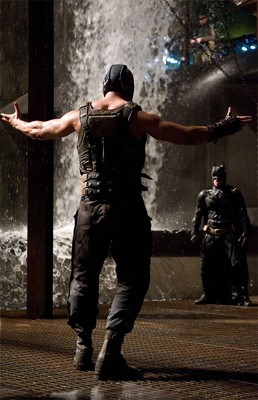 The city of Gotham remains a collective character of its own in The Dark Knight Rises, heightened by newly-introduced faces that operate as the paragons and deviants that populate the metropolitan area, products of its corruption similar to that of Bruce Wayne. Aside from Lieutenant James Gordon, whom Gary Oldman once again handles admirably, Joseph Gordon-Levitt becomes the portrait of integrity and virtue as "hot-headed" cop John Blake, whose ties with an orphanage provides an added emotional facet to the conflict that'll arise later on. Perhaps the most interesting, though, is Selina Kyle, an expert thief who first associates with Bruce Wayne as a mark for her talent. Anne Hathaway expertly distills sauciness, desperation, and malleability in this take on the ... uh, "feline" renegade who wishes for nothing but a better life and a clean slate, offering a compelling counterpoint to both Batman and Bruce Wayne as an entity who slips in and out of the same shadows that the hero hides within. The urge might arise to dismiss these characters as superfluous entities in terms of how they apply to the main plot, something of a recurring issue with Nolan's work, yet their solidly-written presence as byproducts of Gotham City's uglier side are more vital than their superficial purposes.
The city of Gotham remains a collective character of its own in The Dark Knight Rises, heightened by newly-introduced faces that operate as the paragons and deviants that populate the metropolitan area, products of its corruption similar to that of Bruce Wayne. Aside from Lieutenant James Gordon, whom Gary Oldman once again handles admirably, Joseph Gordon-Levitt becomes the portrait of integrity and virtue as "hot-headed" cop John Blake, whose ties with an orphanage provides an added emotional facet to the conflict that'll arise later on. Perhaps the most interesting, though, is Selina Kyle, an expert thief who first associates with Bruce Wayne as a mark for her talent. Anne Hathaway expertly distills sauciness, desperation, and malleability in this take on the ... uh, "feline" renegade who wishes for nothing but a better life and a clean slate, offering a compelling counterpoint to both Batman and Bruce Wayne as an entity who slips in and out of the same shadows that the hero hides within. The urge might arise to dismiss these characters as superfluous entities in terms of how they apply to the main plot, something of a recurring issue with Nolan's work, yet their solidly-written presence as byproducts of Gotham City's uglier side are more vital than their superficial purposes.
Bane's presence, however, triggers thoughts of another significant storyline in Batman's universe, which becomes the ultimate driving force behind The Dark Knight Rises: a true match, a lynchpin, to the hero's prowess and determination during a time when he's needed most. Heath Ledger's Joker raised the bar rather high for any future villains that'd emerge in Nolan's overarching narrative, but Bane comes much closer to matching that menacing presence than expected; he's more structured, methodical, and driven by a concrete ideal, but it's that clutch he has on his motivation -- and Hardy's overall intimidating stature -- that embolden his tenacity. Through Hardy's thick, rather indistinguishable accent and a tack-sharp intellect that actually befits the character (unlike the abomination of a henchman in Batman & Robin), Bane orchestrates a plan through an agenda that astutely revisits the antagonistic themes present in Batman Begins, about the decadence and corruption of Gotham being irreparable without somebody hitting the restart button for the city's citizens. The moral grayness here is engrossing.
Chris and Jonathan Nolan tackle a metric ton of content as Bane's plan to dismantle Gotham takes shape, enough to make well over two and a half hours of hefty, dialogue-heavy content effortlessly weave together with the lofty social musings and byzantine plot devices that hallmark the franchise. Yet, the Nolans's writing also asks the audience to tolerate some lapses in logic and practicality -- as well as engaging in critical interpretation and to not take certain scenes quite so literally -- when grasping the scope of their design this time around, something they're talented enough to avoid; they've always exhibited painstaking eyes for detail, yet a few overzealous flourishes of exposition and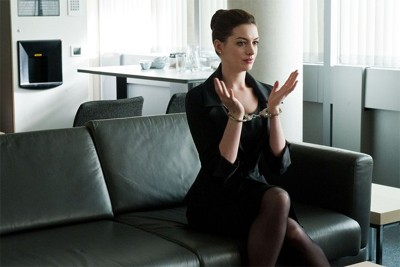 bombast produce some instability in their architecture. Could Batman's identity be discovered like that? Would the police force really make that decision? How did Bruce Wayne get from there to there? And so on and so forth. The ideas they spark justify whatever issues arise in the writing's clarity, though, framing Gotham's frightening collapse in raw contemplation about terrorism, the economy, militaristic control and even usage of alternate forms of energy. This isn't their tightest writing job, even negligent in certain areas, but it's arguably their most ambitious and viscerally involving.
bombast produce some instability in their architecture. Could Batman's identity be discovered like that? Would the police force really make that decision? How did Bruce Wayne get from there to there? And so on and so forth. The ideas they spark justify whatever issues arise in the writing's clarity, though, framing Gotham's frightening collapse in raw contemplation about terrorism, the economy, militaristic control and even usage of alternate forms of energy. This isn't their tightest writing job, even negligent in certain areas, but it's arguably their most ambitious and viscerally involving.
The Dark Knight Rises leads to a point where Gotham City once again comes under attack, only the stakes are far higher by way of Bane's plotting -- and it's made quite apparent through the film's bracing visual and artistic tempo. In Batman Begins, the city fell under attack with a limited number of people being aware of Ra's al Ghul's threat; in The Dark Knight, the Joker's terrorist activities were broadcast on television and involved a substantial number of people affected by his demands; in Rises, however, every single citizen of Gotham knows they're under siege, and feel the immediate pressure. Nolan clearly wants to create an aesthetic hybrid of the previous two films while depicting this chaos, which shines through Wally Pfister's strikingly meticulous shots of a desolate, ice-laden Gotham and Hans Zimmer's score powering it in the backdrop, conveying palpable mayhem and destitution. This time, the crew incorporates a substantial uptick in IMAX footage, adding range and depth to hand-to-hand brawls, car chases, and authoritative acts of violence that bleed together much more seamlessly than the footage in The Dark Knight, partially because of the frequency but also because of the scenes' "necessary" breadth.
Thinking back to the choppy, blitzed hand-to-hand sequences in Batman Begins and marveling at how seamlessly put-together everything appears here, it's astonishing to see exactly how far Nolan and his crew have progressed in the technical department -- mostly, of course, in the action set-pieces. The camera's allowed to linger in The Dark Knight Rises, whether Selina Kyle braces a Wayne Enterprises suit against a wall or Bane and Batman brawl in arguably one of the film's crowning sensory achievements, and that steady-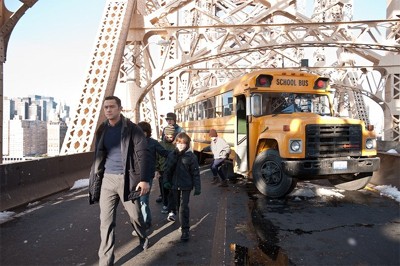 handed focus persists throughout explosive motorcycle and air-vehicle chases that could've spun and sputtered out of control. From start to finish, however, Nolan orchestrates bleak, exhilarating, and polished grand-scale filmmaking of the highest accord, showcasing the proper points to go overboard and when to restrain the perspective to a simpler, sleeker level. This is no chance occurrence; it's the product of seven years of refinement and operating on a learning curve, where the director of an indie project like Memento molded his subversive filmmaking angle onto a massive, imaginative scale.
handed focus persists throughout explosive motorcycle and air-vehicle chases that could've spun and sputtered out of control. From start to finish, however, Nolan orchestrates bleak, exhilarating, and polished grand-scale filmmaking of the highest accord, showcasing the proper points to go overboard and when to restrain the perspective to a simpler, sleeker level. This is no chance occurrence; it's the product of seven years of refinement and operating on a learning curve, where the director of an indie project like Memento molded his subversive filmmaking angle onto a massive, imaginative scale.
Perhaps the most unexpected thing about The Dark Knight Rises is Christopher Nolan's openness to bucking his nihilistic conventions for a crowd-pleasing, comprehensive resolution to the hero's journey, balancing one of his signature interpretive endings with odes to moments across the series (and the comics). He weaves a plot twist involving Bane's motivations -- and a stony, windswept cylindrical prison out on the middle ofIndia nowhere -- with a brisk rush to save Gotham, bringing the story full-circle to the original idea of Batman being a faceless, enduring presence that'll persevere as long as Gotham needs the entity. And while Nolan doesn't make the penultimate conclusion one with a completely straightforward answer, leaving certain elements up to the audience's imagination in terms of Batman's fate, he focuses the ending's viewpoint in a way that, at the very least, conveys an optimistic look at Gotham's future. The bittersweet nature of it all achieves a deeply-felt and rewarding sensation following the rigorous bedlam that Christopher Nolan drags his audience through, lending even more credence to the weight of those hopeful chalk bat-symbols scrawled across the city. It's an impressive finale.
The Blu-ray:
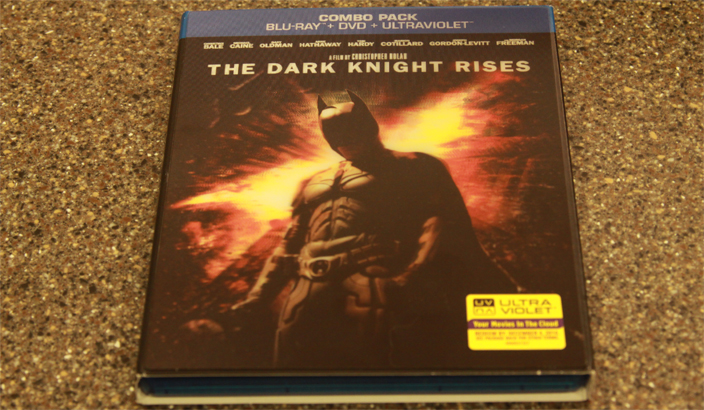
Warner Brothers have prepared a Blu-ray package for The Dark Knight Rises that closely resembles its predecessor, including three discs -- two Blu-rays and a third, unrelated disc -- contained in a standard blue case with an inner swinging tray. A cardboard lenticular slipcase replicates one of the oft-appearing poster designs surrounding the film's marketing, where the flaming bat-symbol fluctuates in red hues to create the illusion of fire. Disc Three, however, is a standard-definition disc this time around, while an Ultraviolet Digital Copy can be found among the promo slips included.
Video and Audio:
Those fearing a repeat of the treatment that Warner Brother gave The Dark Knight can put their minds at ease. Oh, sure, the glorious demo-worthy IMAX footage for Christopher Nolan's latest film does rise above the alternate sequences, framed at 1.78:1 instead of the 2.35:1 aspect ratio befitting the remainder of the 1080p AVC treatment, but there's far less of a discrepancy between those shots and the non-IMAX footage as they shift this time around. Harshness, edge enhancement, and inaccurate coloring are nowhere to be found here, and aside from a few mildly soft sequences, Pfister's cinematography looks absolutely smashing at all points and wholly accurate to the theatrical appearance -- aside from the IMAX aspect ratio being adjusted. The icy blues, slate-leaning oranges, and textured grays of war-zone Gotham are shown due diligence through the disc's handling of the color palette, while the depth of the shadows reveals inky, unobtrusive contrast levels that create the shadows around our hero. Grain retains a natural presence, close-ups reveal robust skin tones and nimble depth, and the 24fps movement creates an immensely satisfying home-theater exhibition.
Looking back, this 5-channel Master Audio track easily towers over the handful of theatrical showings I experienced over the summer. A big chunk of the audio treatment's prowess comes in the clarity of Bane's muffled, faintly electronic voice, coming in razor-sharp and thoroughly captivating in a way that even state-of-the-art IMAX and non-IMAX screenings couldn't achieve -- though, the dialogue was never completely indiscernible at the theater, mind you. The rest of the track performs similarly to that of the TrueHD offering in The Dark Knight: aggressive but mindful bass during explosions and fist-fights, verbal clarity that teeters between merely suitable to dynamic and aware of the environment, and heavily aware of the balance between Hans Zimmer's vigorous score and the atmosphere created in the sound design. A few sound elements stand out, naturally -- the revving of a Lamborghini Aventador's engine, the clank of Selina Kyle's steel heel, the cascade of water in the Bat cave, and the pierce of rockets through the air -- while some of those very elements expand to all channels for a sprawling, captivating aural design. Tremendous work.
Special Features:
Alongside the feature itself, there unfortunately aren't any on-disc supplements for Disc One. However, what has been made available is The Dark Knight Rises Second Screen app integration (look above for screen captures), which serves many of the same purposes as a picture-in-picture track on the disc itself. I'm divided on how to feel about this; this integration provides an intuitive experience that allows for app-to-machine control while photos and textual material appear about the scenes currently on-screen, but making it exclusive only to those with an applicable devices doesn't score well in my books. Perhaps it wouldn't have mattered if the layout, and the content within, hadn't been of this caliber: lengthy videos, detailed production sketches, and extremely discerning pieces of "trivia" playable on-the-fly -- which, actually, is much more pertinent material than it sounds -- make downloading the free app and syncing it with the Blu-ray a seamless post-screening session. The fact that you can flip through the app and sync the Blu-ray with the related material pushes it over the edge, and it's a cinch to get ready over a wireless connection. But, really, this should've been on the disc in another format.
Disc Two comes pretty damn close to making someone forget about the lack of a picture-in-picture function, especially once you open up the Ending the Knight section and realize that much of the Second Screen content makes an appearance in these snippets. Split into three sections -- Production, Characters, and Reflections (all in HD) -- each individual piece typically lasts roughly between five to eight minutes, blending interviews with Chris Nolan, Wally Pfister, the cast and the production crew with behind-the-scenes footage and stills that paint very, very clear pictures of the elaborate orchestrations. The goal of these pieces is to make those watching gain a higher, more appreciative understanding of the craft and artistry diligently poured into each sequence, and these slates of material achieve that with efficiency and depth.
The Production section clobbers those watching over the head with the enormous scale of these set-pieces, but it also reinforces the point that Christopher Nolan tries his hardest to make them look and feel as authentic as possible -- through careful, sparse computer-generated effects, mixed-form photography, and as much naturally-made material as they could handle. These pieces reveal the difficulties and necessities in shooting the plane heist (The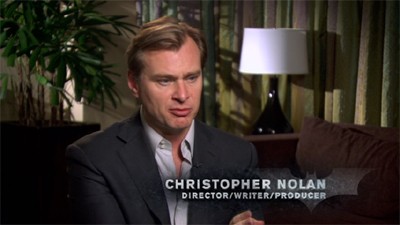 Prologue) with IMAX cameras above Scotland and the application of slate, steel, and water into the constructed set for the Batcave (Return to the Batcave) and Bane's lair (Beneath Gotham), underscored by several incredible stretches of time-lapse footage that reveal their meticulous assembly. But they also bring the scale a bit lower by revealing the origin of atmospheric effects, such as the components of creating the Gotham Rogues football team (Gameday Destruction) and how Hans Zimmer repurposed the rhythm of the prison chant into a persistent, raw audio element (The Chant). All twelve pieces are terrific in their own right.
Prologue) with IMAX cameras above Scotland and the application of slate, steel, and water into the constructed set for the Batcave (Return to the Batcave) and Bane's lair (Beneath Gotham), underscored by several incredible stretches of time-lapse footage that reveal their meticulous assembly. But they also bring the scale a bit lower by revealing the origin of atmospheric effects, such as the components of creating the Gotham Rogues football team (Gameday Destruction) and how Hans Zimmer repurposed the rhythm of the prison chant into a persistent, raw audio element (The Chant). All twelve pieces are terrific in their own right.
The Characters section takes the revelatory tempo away from detail-oriented exploration to elaboration and study of the lore and mythos, central being a well-felt exploration of Bruce Wayne (The Journey of Bruce Wayne) where interviews with Nolan, his writers, and Christian Bale take us through the process of his evolution, and where his psyche exists in The Dark Knight Rises. Gotham's Reckoning turns the lens towards Bane, revealing how they wanted to reconstruct the character in Nolan's universe as a less-fanciful, primal mercenary that still latches firmly onto the presence of the comics, along with how they reached a decision about exactly how "large" Hardy's version of Bane would be. A Girl's Gotta Eat explores how Anne Hathaway rather sharply arrives at her and Chris' interpretation of the character, involving her exploration of the comics, Bob Kane's original intentions, and even a focus on Hedy Lamarr -- and it shows exactly how seriously she and the crew took molding her presence, down to the practical application of her mask.
The material present in the Reflections wing will be a bit congratulatory for some tastes, focusing on general artistry in Shadows & Light in Large Format and Christopher Nolan himself in The End of a Legend, but the condensed interviews within are worthwhile enough as a capper to those other special features. They provide a perfect segue to the lighter, more perfunctory remaining special features: The Trailer Archive (8:35, HD), which paints an observable picture of the mounting anticipation behind seeing this story take place, and a collection of thirty easy-to-find posters and designs in the Print Campaign Art Gallery.
Final Thoughts:
Christopher Nolan had the potential to go in several directions with The Dark Knight Rises, yet what he produces is something of a surprise: a captivating, aggressive, occasionally frenzied climax to the trilogy that balances somberness and elevated ideas with doting reflections on the journey Bruce Wayne has traveled. This is neither Nolan's best film nor the crowning achievement of the series, largely due to a rushed and inconsistent rhythm in the writing, but that doesn't stop the comic-book blockbuster from achieving quite a bit of mastery through thought-provoking concepts in Gotham's conflicts and an examination of Bruce Wayne's damaged psyche. The action is superbly polished and paced extraordinarily well across more than two-and-a-half hours, the performances range from par-for-the-course to sublime, and the ending itself -- one that's both vaguely interpretive and point-blank rewarding -- leaves one pondering exactly how the idea of Batman will rise again in the future. It's a flawed masterstroke of a conclusion, whose ambition and raw energy overcome most qualms over its practicality and clarity.
Warner Bros. have earned a roaring round of applause for this Blu-ray of Rises: learning from the peculiar mistakes of The Dark Knight, they've presented the film's shifting aspect ratios with a properly-balanced, impressive quality between the alternations that's, put simply, gorgeous and authentic. The audio presentation also exhibits impressive attributes that excel beyond the theatrical presence, while a slate of condensed, focused featurettes -- and an hour-long documentary on the Batmobile -- assemble a robust special-features package that'll satisfy those Batman devotees who won't be patient enough to wait for the imminent "ultimate edition" of all the films. Highly Recommended.
Thomas Spurlin, Staff Reviewer -- DVDTalk Reviews | Personal Blog/Site

In The Dark Knight Rises, Christopher Nolan's grand conclusion to his Batman trilogy, an unassuming scene captures the essence of what resonates with me in this outlook on the hero: a beat cop turned detective, John Blake (Joseph Gordon-Levitt), walks the streets of a ravaged, desolate Gotham, using a piece of chalk to draw modified Bat-symbols. It's an emblem of hope and fortitude, during a time when there's no assurance that the city's demonized guardian would pull them from the vice of anarchy threatening to wipe Gotham off the face of the map. Orchestrated with bombast to spare, the situation leaves one wondering whether they'll even be able to survive this hopelessness, marked by lethal twists-'n-turns and a decimated social infrastructure. To say that the execution of Rises' revolutionary setting comes as a surprise -- both in rewarding conventionalism and how it pushes realism to the edge of plausibility for its complex theatrics -- would be an understatement, and the way the hero emerges to answer the call of those chalked symbols does nothing short of exhilarate.
From the beginning, Nolan and his writers -- David S. Goyer for Begins, Jonathan Nolan for The Dark Knight and Rises -- have incorporated elements of the graphic novels into their trilogy, only tweaked to fit into the universe's tone and realism. Taking pages from "The Dark Knight Returns" at first, where they set up a point for an older, retired, grieving Batman to reemerge, the story advances forward eight years to a time when
 organized crime has been largely contained through an initiative called the Dent Act. Following the events of The Dark Knight, where Batman is forced to hide in the shadows due to suspicion of murder, Bruce Wayne (Christian Bale) lets himself wither in the halls of his echoic lofts of his mansion, lamenting the losses of loved ones and brooding over his moral choice for the greater good of Gotham. This peace doesn't last, though: a new threat, the muscular and masked idealist named Bane (Tom Hardy), gradually plants seeds of destruction around the city that drives Batman out of the shadows, once he delivers a personal blow to Bruce. He's there to make sure that Gotham is reduced to ashes, but not without suffering.
organized crime has been largely contained through an initiative called the Dent Act. Following the events of The Dark Knight, where Batman is forced to hide in the shadows due to suspicion of murder, Bruce Wayne (Christian Bale) lets himself wither in the halls of his echoic lofts of his mansion, lamenting the losses of loved ones and brooding over his moral choice for the greater good of Gotham. This peace doesn't last, though: a new threat, the muscular and masked idealist named Bane (Tom Hardy), gradually plants seeds of destruction around the city that drives Batman out of the shadows, once he delivers a personal blow to Bruce. He's there to make sure that Gotham is reduced to ashes, but not without suffering. The Dark Knight generated substantial critical success, but one impression frequently emerges about the anarchy that The Joker brought onto Gotham: it wasn't as focused on being a comic-book movie like Batman Begins, despite an imposing and impressive presence. While I hesitate to say that this changes significantly with Rises, Nolan and his creative crew have certainly brought the material closer to that stature. Gathering thematic elements spread across the trilogy, from Batman as an elemental representation and Bruce Wayne "picking himself up" from adversity to the symbolic destruction of Gotham City, Nolan gives his ideas an unrestrained, persistent presence while exploring the billionaire's damaged psychosis. In fact, it wouldn't be unreasonable to say that Rises focuses far less on Batman as an entity himself; Wayne's melancholy seclusion, his defeatist attitude when talking to his dutiful father-figure butler, Alfred (Michael Caine), and his Wayne Enterprises "tech consultant" Lucius Fox (Morgan Freeman), and his reluctant reemergence in society -- and into a new relationship with sustainable-energy proponent Miranda Tate (Marion Cotillard) -- run parallel to the tainted essence of the city he dedicated his life to defending under a thankless mask. A mythical quality stirs here, underscored by iconic visual reflections from the books repurposed for Nolan's context.
 The city of Gotham remains a collective character of its own in The Dark Knight Rises, heightened by newly-introduced faces that operate as the paragons and deviants that populate the metropolitan area, products of its corruption similar to that of Bruce Wayne. Aside from Lieutenant James Gordon, whom Gary Oldman once again handles admirably, Joseph Gordon-Levitt becomes the portrait of integrity and virtue as "hot-headed" cop John Blake, whose ties with an orphanage provides an added emotional facet to the conflict that'll arise later on. Perhaps the most interesting, though, is Selina Kyle, an expert thief who first associates with Bruce Wayne as a mark for her talent. Anne Hathaway expertly distills sauciness, desperation, and malleability in this take on the ... uh, "feline" renegade who wishes for nothing but a better life and a clean slate, offering a compelling counterpoint to both Batman and Bruce Wayne as an entity who slips in and out of the same shadows that the hero hides within. The urge might arise to dismiss these characters as superfluous entities in terms of how they apply to the main plot, something of a recurring issue with Nolan's work, yet their solidly-written presence as byproducts of Gotham City's uglier side are more vital than their superficial purposes.
The city of Gotham remains a collective character of its own in The Dark Knight Rises, heightened by newly-introduced faces that operate as the paragons and deviants that populate the metropolitan area, products of its corruption similar to that of Bruce Wayne. Aside from Lieutenant James Gordon, whom Gary Oldman once again handles admirably, Joseph Gordon-Levitt becomes the portrait of integrity and virtue as "hot-headed" cop John Blake, whose ties with an orphanage provides an added emotional facet to the conflict that'll arise later on. Perhaps the most interesting, though, is Selina Kyle, an expert thief who first associates with Bruce Wayne as a mark for her talent. Anne Hathaway expertly distills sauciness, desperation, and malleability in this take on the ... uh, "feline" renegade who wishes for nothing but a better life and a clean slate, offering a compelling counterpoint to both Batman and Bruce Wayne as an entity who slips in and out of the same shadows that the hero hides within. The urge might arise to dismiss these characters as superfluous entities in terms of how they apply to the main plot, something of a recurring issue with Nolan's work, yet their solidly-written presence as byproducts of Gotham City's uglier side are more vital than their superficial purposes. Bane's presence, however, triggers thoughts of another significant storyline in Batman's universe, which becomes the ultimate driving force behind The Dark Knight Rises: a true match, a lynchpin, to the hero's prowess and determination during a time when he's needed most. Heath Ledger's Joker raised the bar rather high for any future villains that'd emerge in Nolan's overarching narrative, but Bane comes much closer to matching that menacing presence than expected; he's more structured, methodical, and driven by a concrete ideal, but it's that clutch he has on his motivation -- and Hardy's overall intimidating stature -- that embolden his tenacity. Through Hardy's thick, rather indistinguishable accent and a tack-sharp intellect that actually befits the character (unlike the abomination of a henchman in Batman & Robin), Bane orchestrates a plan through an agenda that astutely revisits the antagonistic themes present in Batman Begins, about the decadence and corruption of Gotham being irreparable without somebody hitting the restart button for the city's citizens. The moral grayness here is engrossing.
Chris and Jonathan Nolan tackle a metric ton of content as Bane's plan to dismantle Gotham takes shape, enough to make well over two and a half hours of hefty, dialogue-heavy content effortlessly weave together with the lofty social musings and byzantine plot devices that hallmark the franchise. Yet, the Nolans's writing also asks the audience to tolerate some lapses in logic and practicality -- as well as engaging in critical interpretation and to not take certain scenes quite so literally -- when grasping the scope of their design this time around, something they're talented enough to avoid; they've always exhibited painstaking eyes for detail, yet a few overzealous flourishes of exposition and
 bombast produce some instability in their architecture. Could Batman's identity be discovered like that? Would the police force really make that decision? How did Bruce Wayne get from there to there? And so on and so forth. The ideas they spark justify whatever issues arise in the writing's clarity, though, framing Gotham's frightening collapse in raw contemplation about terrorism, the economy, militaristic control and even usage of alternate forms of energy. This isn't their tightest writing job, even negligent in certain areas, but it's arguably their most ambitious and viscerally involving.
bombast produce some instability in their architecture. Could Batman's identity be discovered like that? Would the police force really make that decision? How did Bruce Wayne get from there to there? And so on and so forth. The ideas they spark justify whatever issues arise in the writing's clarity, though, framing Gotham's frightening collapse in raw contemplation about terrorism, the economy, militaristic control and even usage of alternate forms of energy. This isn't their tightest writing job, even negligent in certain areas, but it's arguably their most ambitious and viscerally involving. The Dark Knight Rises leads to a point where Gotham City once again comes under attack, only the stakes are far higher by way of Bane's plotting -- and it's made quite apparent through the film's bracing visual and artistic tempo. In Batman Begins, the city fell under attack with a limited number of people being aware of Ra's al Ghul's threat; in The Dark Knight, the Joker's terrorist activities were broadcast on television and involved a substantial number of people affected by his demands; in Rises, however, every single citizen of Gotham knows they're under siege, and feel the immediate pressure. Nolan clearly wants to create an aesthetic hybrid of the previous two films while depicting this chaos, which shines through Wally Pfister's strikingly meticulous shots of a desolate, ice-laden Gotham and Hans Zimmer's score powering it in the backdrop, conveying palpable mayhem and destitution. This time, the crew incorporates a substantial uptick in IMAX footage, adding range and depth to hand-to-hand brawls, car chases, and authoritative acts of violence that bleed together much more seamlessly than the footage in The Dark Knight, partially because of the frequency but also because of the scenes' "necessary" breadth.
Thinking back to the choppy, blitzed hand-to-hand sequences in Batman Begins and marveling at how seamlessly put-together everything appears here, it's astonishing to see exactly how far Nolan and his crew have progressed in the technical department -- mostly, of course, in the action set-pieces. The camera's allowed to linger in The Dark Knight Rises, whether Selina Kyle braces a Wayne Enterprises suit against a wall or Bane and Batman brawl in arguably one of the film's crowning sensory achievements, and that steady-
 handed focus persists throughout explosive motorcycle and air-vehicle chases that could've spun and sputtered out of control. From start to finish, however, Nolan orchestrates bleak, exhilarating, and polished grand-scale filmmaking of the highest accord, showcasing the proper points to go overboard and when to restrain the perspective to a simpler, sleeker level. This is no chance occurrence; it's the product of seven years of refinement and operating on a learning curve, where the director of an indie project like Memento molded his subversive filmmaking angle onto a massive, imaginative scale.
handed focus persists throughout explosive motorcycle and air-vehicle chases that could've spun and sputtered out of control. From start to finish, however, Nolan orchestrates bleak, exhilarating, and polished grand-scale filmmaking of the highest accord, showcasing the proper points to go overboard and when to restrain the perspective to a simpler, sleeker level. This is no chance occurrence; it's the product of seven years of refinement and operating on a learning curve, where the director of an indie project like Memento molded his subversive filmmaking angle onto a massive, imaginative scale. Perhaps the most unexpected thing about The Dark Knight Rises is Christopher Nolan's openness to bucking his nihilistic conventions for a crowd-pleasing, comprehensive resolution to the hero's journey, balancing one of his signature interpretive endings with odes to moments across the series (and the comics). He weaves a plot twist involving Bane's motivations -- and a stony, windswept cylindrical prison out on the middle of
The Blu-ray:

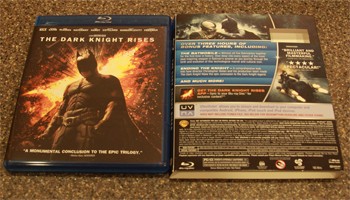 | 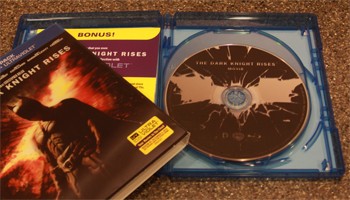 |
Warner Brothers have prepared a Blu-ray package for The Dark Knight Rises that closely resembles its predecessor, including three discs -- two Blu-rays and a third, unrelated disc -- contained in a standard blue case with an inner swinging tray. A cardboard lenticular slipcase replicates one of the oft-appearing poster designs surrounding the film's marketing, where the flaming bat-symbol fluctuates in red hues to create the illusion of fire. Disc Three, however, is a standard-definition disc this time around, while an Ultraviolet Digital Copy can be found among the promo slips included.
Video and Audio:
Those fearing a repeat of the treatment that Warner Brother gave The Dark Knight can put their minds at ease. Oh, sure, the glorious demo-worthy IMAX footage for Christopher Nolan's latest film does rise above the alternate sequences, framed at 1.78:1 instead of the 2.35:1 aspect ratio befitting the remainder of the 1080p AVC treatment, but there's far less of a discrepancy between those shots and the non-IMAX footage as they shift this time around. Harshness, edge enhancement, and inaccurate coloring are nowhere to be found here, and aside from a few mildly soft sequences, Pfister's cinematography looks absolutely smashing at all points and wholly accurate to the theatrical appearance -- aside from the IMAX aspect ratio being adjusted. The icy blues, slate-leaning oranges, and textured grays of war-zone Gotham are shown due diligence through the disc's handling of the color palette, while the depth of the shadows reveals inky, unobtrusive contrast levels that create the shadows around our hero. Grain retains a natural presence, close-ups reveal robust skin tones and nimble depth, and the 24fps movement creates an immensely satisfying home-theater exhibition.
Looking back, this 5-channel Master Audio track easily towers over the handful of theatrical showings I experienced over the summer. A big chunk of the audio treatment's prowess comes in the clarity of Bane's muffled, faintly electronic voice, coming in razor-sharp and thoroughly captivating in a way that even state-of-the-art IMAX and non-IMAX screenings couldn't achieve -- though, the dialogue was never completely indiscernible at the theater, mind you. The rest of the track performs similarly to that of the TrueHD offering in The Dark Knight: aggressive but mindful bass during explosions and fist-fights, verbal clarity that teeters between merely suitable to dynamic and aware of the environment, and heavily aware of the balance between Hans Zimmer's vigorous score and the atmosphere created in the sound design. A few sound elements stand out, naturally -- the revving of a Lamborghini Aventador's engine, the clank of Selina Kyle's steel heel, the cascade of water in the Bat cave, and the pierce of rockets through the air -- while some of those very elements expand to all channels for a sprawling, captivating aural design. Tremendous work.
Special Features:
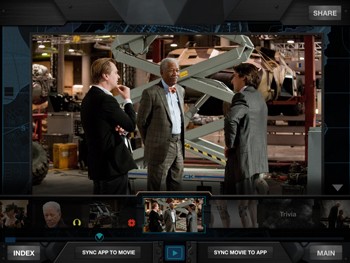 | 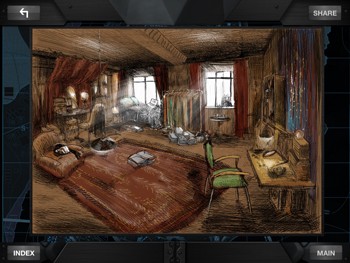 |
Alongside the feature itself, there unfortunately aren't any on-disc supplements for Disc One. However, what has been made available is The Dark Knight Rises Second Screen app integration (look above for screen captures), which serves many of the same purposes as a picture-in-picture track on the disc itself. I'm divided on how to feel about this; this integration provides an intuitive experience that allows for app-to-machine control while photos and textual material appear about the scenes currently on-screen, but making it exclusive only to those with an applicable devices doesn't score well in my books. Perhaps it wouldn't have mattered if the layout, and the content within, hadn't been of this caliber: lengthy videos, detailed production sketches, and extremely discerning pieces of "trivia" playable on-the-fly -- which, actually, is much more pertinent material than it sounds -- make downloading the free app and syncing it with the Blu-ray a seamless post-screening session. The fact that you can flip through the app and sync the Blu-ray with the related material pushes it over the edge, and it's a cinch to get ready over a wireless connection. But, really, this should've been on the disc in another format.
Disc Two comes pretty damn close to making someone forget about the lack of a picture-in-picture function, especially once you open up the Ending the Knight section and realize that much of the Second Screen content makes an appearance in these snippets. Split into three sections -- Production, Characters, and Reflections (all in HD) -- each individual piece typically lasts roughly between five to eight minutes, blending interviews with Chris Nolan, Wally Pfister, the cast and the production crew with behind-the-scenes footage and stills that paint very, very clear pictures of the elaborate orchestrations. The goal of these pieces is to make those watching gain a higher, more appreciative understanding of the craft and artistry diligently poured into each sequence, and these slates of material achieve that with efficiency and depth.
The Production section clobbers those watching over the head with the enormous scale of these set-pieces, but it also reinforces the point that Christopher Nolan tries his hardest to make them look and feel as authentic as possible -- through careful, sparse computer-generated effects, mixed-form photography, and as much naturally-made material as they could handle. These pieces reveal the difficulties and necessities in shooting the plane heist (The
 Prologue) with IMAX cameras above Scotland and the application of slate, steel, and water into the constructed set for the Batcave (Return to the Batcave) and Bane's lair (Beneath Gotham), underscored by several incredible stretches of time-lapse footage that reveal their meticulous assembly. But they also bring the scale a bit lower by revealing the origin of atmospheric effects, such as the components of creating the Gotham Rogues football team (Gameday Destruction) and how Hans Zimmer repurposed the rhythm of the prison chant into a persistent, raw audio element (The Chant). All twelve pieces are terrific in their own right.
Prologue) with IMAX cameras above Scotland and the application of slate, steel, and water into the constructed set for the Batcave (Return to the Batcave) and Bane's lair (Beneath Gotham), underscored by several incredible stretches of time-lapse footage that reveal their meticulous assembly. But they also bring the scale a bit lower by revealing the origin of atmospheric effects, such as the components of creating the Gotham Rogues football team (Gameday Destruction) and how Hans Zimmer repurposed the rhythm of the prison chant into a persistent, raw audio element (The Chant). All twelve pieces are terrific in their own right. The Characters section takes the revelatory tempo away from detail-oriented exploration to elaboration and study of the lore and mythos, central being a well-felt exploration of Bruce Wayne (The Journey of Bruce Wayne) where interviews with Nolan, his writers, and Christian Bale take us through the process of his evolution, and where his psyche exists in The Dark Knight Rises. Gotham's Reckoning turns the lens towards Bane, revealing how they wanted to reconstruct the character in Nolan's universe as a less-fanciful, primal mercenary that still latches firmly onto the presence of the comics, along with how they reached a decision about exactly how "large" Hardy's version of Bane would be. A Girl's Gotta Eat explores how Anne Hathaway rather sharply arrives at her and Chris' interpretation of the character, involving her exploration of the comics, Bob Kane's original intentions, and even a focus on Hedy Lamarr -- and it shows exactly how seriously she and the crew took molding her presence, down to the practical application of her mask.
The material present in the Reflections wing will be a bit congratulatory for some tastes, focusing on general artistry in Shadows & Light in Large Format and Christopher Nolan himself in The End of a Legend, but the condensed interviews within are worthwhile enough as a capper to those other special features. They provide a perfect segue to the lighter, more perfunctory remaining special features: The Trailer Archive (8:35, HD), which paints an observable picture of the mounting anticipation behind seeing this story take place, and a collection of thirty easy-to-find posters and designs in the Print Campaign Art Gallery.
Final Thoughts:
Christopher Nolan had the potential to go in several directions with The Dark Knight Rises, yet what he produces is something of a surprise: a captivating, aggressive, occasionally frenzied climax to the trilogy that balances somberness and elevated ideas with doting reflections on the journey Bruce Wayne has traveled. This is neither Nolan's best film nor the crowning achievement of the series, largely due to a rushed and inconsistent rhythm in the writing, but that doesn't stop the comic-book blockbuster from achieving quite a bit of mastery through thought-provoking concepts in Gotham's conflicts and an examination of Bruce Wayne's damaged psyche. The action is superbly polished and paced extraordinarily well across more than two-and-a-half hours, the performances range from par-for-the-course to sublime, and the ending itself -- one that's both vaguely interpretive and point-blank rewarding -- leaves one pondering exactly how the idea of Batman will rise again in the future. It's a flawed masterstroke of a conclusion, whose ambition and raw energy overcome most qualms over its practicality and clarity.
Warner Bros. have earned a roaring round of applause for this Blu-ray of Rises: learning from the peculiar mistakes of The Dark Knight, they've presented the film's shifting aspect ratios with a properly-balanced, impressive quality between the alternations that's, put simply, gorgeous and authentic. The audio presentation also exhibits impressive attributes that excel beyond the theatrical presence, while a slate of condensed, focused featurettes -- and an hour-long documentary on the Batmobile -- assemble a robust special-features package that'll satisfy those Batman devotees who won't be patient enough to wait for the imminent "ultimate edition" of all the films. Highly Recommended.
|
| Popular Reviews |
| Sponsored Links |
|
|
| Sponsored Links |
|
|
| Release List | Reviews | Shop | Newsletter | Forum | DVD Giveaways | Blu-Ray | Advertise |
|
Copyright 2024 DVDTalk.com All Rights Reserved. Legal Info, Privacy Policy, Terms of Use,
Manage Preferences,
Your Privacy Choices | |||||||









